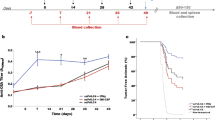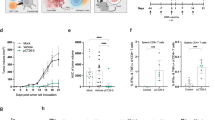Abstract
Carcinoembryonic antigen (CEA, CEACAM5) is expressed on several human carcinomas including colon cancer. CEA contains signal peptides that target the protein through the endoplasmic reticulum and to the cell membrane. We constructed a plasmid DNA vaccine encoding a truncated CEA (ΔCEA), devoid of its signal peptides, and demonstrated that it was retained inside the cell, while full-length CEA (wtCEA) was expressed on the membrane. We hypothesized that intracellular retention of ΔCEA would enhance MHC class I presentation of CEA peptides, thus favoring cellular immune responses. In addition, a promiscuous T-helper epitope (Q830-L844 of tetanus toxoid) was fused to the N-terminal of the truncated CEA gene (tetΔCEA). C57BL/6 mice immunized with DNA encoding wtCEA or tetΔCEA developed both humoral and cellular immune responses to CEA. SCID mice transplanted with spleen cells from tetΔCEA but not wtCEA-immunized C57BL/6 mice showed strong suppression of tumor growth after inoculation of human CEA-expressing colon carcinoma cells. Immune spleen cell populations depleted for either B, T or both B and T cells were active, indicating that effector cells might also reside in other populations. The present approach to manipulating antigen presentation may open new possibilities for immunotherapy against colon and other CEA-secreting carcinomas.
This is a preview of subscription content, access via your institution
Access options
Subscribe to this journal
Receive 12 print issues and online access
$259.00 per year
only $21.58 per issue
Buy this article
- Purchase on Springer Link
- Instant access to full article PDF
Prices may be subject to local taxes which are calculated during checkout







Similar content being viewed by others
References
Gold P, Freedman SO . Specific carcinoembryonic antigens of the human digestive system. J Exp Med. 1965;122:467–481.
Hammarström S . The carcinoembryonic antigen (CEA) family: structure, suggested functions and expression in normal and malignant tissues. Semin Cancer Biol. 1999;9:67–81.
Beauchemin N, Draber P, Dveksler G, et al. Redefined nomenclature for members of the carcinoembryonic family. Exp Cell Res. 1999;252:243–249.
Wahren B, Gadler F, Gahrton G, et al. NCA: a differentiation antigen of myelopoietic cells in humans and hominoid monkeys. Ann NY Acad Sci. 1983;417:344–358.
Hefta LJ, Chen FS, Ronk M, et al. Expression of carcinoembryonic antigen and its predicted immunoglobulin-like domains in HeLa cells for epitope analysis. Cancer Res. 1993;52:5647–5655.
Maxwell-Armstrong CA, Durrant LG, Scholefield JH . Colorectal cancer vaccines. Br J Surg. 1998;85:149–154.
Foon KA, Chakraborty M, John WJ, Sherratt A, Kohler H, Bhattacharya-Chatterjee M . Immune response to the carcinoembryonic antigen in patients treated with an anti-idiotype antibody vaccine. J Clin Invest. 1995;96:334–342.
Mavligit GM, Stuckey S . Colorectal carcinoma. Evidence for circulating CEA-anti-CEA complexes. Cancer. 1983;52:146–149.
Staab HJ, Anderer FA, Stumpf E, Fischer R . Are circulating CEA immune complexes a prognostic marker in patients with carcinoma of the gastrointestinal tract? Br J Cancer. 1980;42:26–33.
Chester KA, Begent RH . Circulating immune complexes (CIC), carcinoembryonic antigen (CEA) and CIC containing CEA as markers for colorectal cancer. Clin Exp Immunol. 1984;58:685–693.
Collatz E, Von Kleist S, Burtin P . Further investigations of circulating antibodies in colon cancer patients: on the autoantigenicity of the carcinoembryonic antigen. Int J Cancer. 1971;8:298–303.
Durrant LG, Denton GW, Jacobs E, et al. An idiotypic replica of carcinoembryonic antigen inducing cellular and humoral responses directed against human colorectal tumours. Int J Cancer. 1992;50:811–816.
Kantor J, Irvine K, Abrams S, Kaufman H, DiPietro J, Schlom J . Antitumor activity and immune responses induced by a recombinant carcinoembryonic antigen-vaccinia virus vaccine. J Natl Cancer Inst. 1992;84:1084–1091.
Tsang KY, Zaremba S, Nieroda CA, Zhu MZ, Hamilton JM, Schlom J . Generation of human cytotoxic T cells specific for human carcinoembryonic antigen epitopes from patients immunized with recombinant vaccinia-CEA vaccine [see comments]. J Natl Cancer Inst. 1995;87:982–990.
Samanci A, Yi Q, Fagerberg J, et al. Pharmacological administration of granulocyte/macrophage-colony-stimulating factor is of significant importance for the induction of a strong humoral and cellular response in patients immunized with recombinant carcinoembryonic antigen. Cancer Immunol Immunother. 1998;47:131–142.
Cohen AD, Boyer JD, Weiner DB . Modulating the immune response to genetic immunization. Faseb J. 1998;12:1611–1626.
Fynan EF, Webster RG, Fuller DH, Haynes JR, Santoro JC, Robinson HL . DNA vaccines: protective immunizations by parenteral, mucosal, and gene- gun inoculations. Proc Natl Acad Sci USA. 1993;90:11478–11482.
Ulmer JB, Donnelly JJ, Parker SE, et al. Heterologous protection against influenza by injection of DNA encoding a viral protein. Science. 1993;259:1745–1749.
Wang B, Ugen KE, Srikantan V, et al. Gene inoculation generates immune responses against human immunodeficiency virus type 1. Proc Natl Acad Sci USA. 1993;90:4156–4160.
Calarota S, Bratt G, Nordlund S, et al. Cellular cytotoxic response induced by DNA vaccination in HIV-1- infected patients. Lancet. 1998;351:1320–1325.
Davis HL, Michel ML, Mancini M, Schleef M, Whalen RG . Direct gene transfer in skeletal muscle: plasmid DNA-based immunization against the hepatitis B virus surface antigen. Vaccine. 1994;12:1503–1509.
Conry RM, White SA, Fultz PN, et al. Polynucleotide immunization of nonhuman primates against carcinoembryonic antigen. Clin Cancer Res. 1998;4:2903–2912.
Smith BF, Baker HJ, Curiel DT, Jiang W, Conry RM . Humoral and cellular immune responses of dogs immunized with a nucleic acid vaccine encoding human carcinoembryonic antigen. Gene Therapy. 1998;5:865–868.
Chin L-T, Malmborg A-C, Kristensson K, Hinkula J, Wahren B, Borrebaeck C . Mimicking the humoral immune response in vitro results in antigen-specific isotype switching supported by specific autologous T helper cells: generation of human HIV-1-neutralizing IgG monoclonal antibodies from naive donors. Eur. J Immunol. 1995;25:657–663.
King C, Spellerberg M, Zhu D, et al. DNA vaccines with a single-chain Fv fused to a fragment C of tetanus toxin induce protective immunity against lymphoma and myeloma. Nat Med. 1998;4:1281–1286.
Beauchemin N, Benchimol S, Cournoyer D, Fuks A, Stanners CP . Isolation and characterization of full-length functional cDNA clones for human carcinoembryonic antigen. Mol Cell Biol. 1987;7:3221–3230.
Kozak M . How do eucaryotic ribosomes select initiation regions in messenger RNA? Cell. 1978;15:1109–1123.
Kjerrström A, Wahren B . Expression of HIV regulatory DNA vaccine constructs. Biogenic Amines. 1999;15:93–112.
Boyle JS, Koniaras C, Lew AM . Influence of cellular location of expressed antigen on the efficacy of DNA vaccination: cytotoxic T lymphocyte and antibody responses are suboptimal when antigen is cytoplasmic after intramuscular DNA immunization. Int Immunol. 1997;9:1897–1906.
Todryk SM, Chong H, Vile RG, Pandha H, Lemoine NR . Can immunotherapy by gene transfer tip the balance against colorectal cancer? Gut. 1998;43:445–449.
Pardoll D . Cancer vaccines. Nat Med. 1998;4:525–531.
Kloetzel PM . The proteasome system: a neglected tool for improvement of novel therapeutic strategies? [editorial]. Gene Therapy. 1998;5:1297–1298.
Haddad D, Liljeqvist S, Stahl S, et al. Comparative study of DNA-based immunization vectors: effect of secretion signals on the antibody responses in mice. FEMS Immunol Med Microbiol. 1997;18:193–202.
Rice J, Elliott T, Buchan S, Stevenson FK . DNA fusion vaccine designed to induce cytotoxic T cell responses against defined peptide motifs: implications for cancer vaccines. J Immunol. 2001;167:1558–1565.
Schofield L, McConville MJ, Hansen D, et al. CD1d-restricted immunoglobulin G formation to GPI-anchored antigens mediated by NKT cells. Science. 1999;283:225–229.
Slingluff Jr CL, Yamshchikov G, Neese P, et al. Phase I trial of a melanoma vaccine with gp100(280–288) peptide and tetanus helper peptide in adjuvant: immunologic and clinical outcomes. Clin Cancer Res. 2001;7:3012–3024.
Keitel WA, Kester KE, Atmar RL, et al. Phase I trial of two recombinant vaccines containing the 19kd carboxy terminal fragment of Plasmodium falciparum merozoite surface protein 1 (msp-1(19)) and T helper epitopes of tetanus toxoid. Vaccine. 2000;18:531–539.
Harlowe E, Lane D . Antibodies, A Laboratory Manual. Cold Spring Harbor Laboratory Press; Cold Spring Harbor, N.Y. 1988.
White SA, LoBuglio AF, Arani RB, et al. Induction of anti-tumor immunity by intrasplenic administration of a carcinoembryonic antigen DNA vaccine. J Gene Med. 2000;2:135–140.
Acknowledgements
We thank Sten Hammarström for generous gifts of purified native CEA and N Beauchemin for the p91023(B) plasmid. This work was supported by grants from Cancerföreningen in Stockholm, the Swedish Medical Research Council and the Swedish Medical Society.
Author information
Authors and Affiliations
Rights and permissions
About this article
Cite this article
Lund, L., Andersson, K., Zuber, B. et al. Signal sequence deletion and fusion to tetanus toxoid epitope augment antitumor immune responses to a human carcinoembryonic antigen (CEA) plasmid DNA vaccine in a murine test system. Cancer Gene Ther 10, 365–376 (2003). https://doi.org/10.1038/sj.cgt.7700574
Received:
Published:
Issue Date:
DOI: https://doi.org/10.1038/sj.cgt.7700574
Keywords
This article is cited by
-
Cancer DNA vaccines: current preclinical and clinical developments and future perspectives
Journal of Experimental & Clinical Cancer Research (2019)
-
scFv6.C4 DNA vaccine with fragment C of Tetanus toxin increases protective immunity against CEA-expressing tumor
Gene Therapy (2019)
-
Chimeric Myostatin — Tetanic Toxin Epitopes and Heterologous Prime-boost Immunization Improve Immune Response Stimulating Muscle Growth in Mice
Biotechnology and Bioprocess Engineering (2019)
-
Proteoliposomal formulations of an HIV-1 gp41-based miniprotein elicit a lipid-dependent immunodominant response overlapping the 2F5 binding motif
Scientific Reports (2017)
-
Induction of T cell-mediated immunity using a c-Myb DNA vaccine in a mouse model of colon cancer
Cancer Immunology, Immunotherapy (2008)



